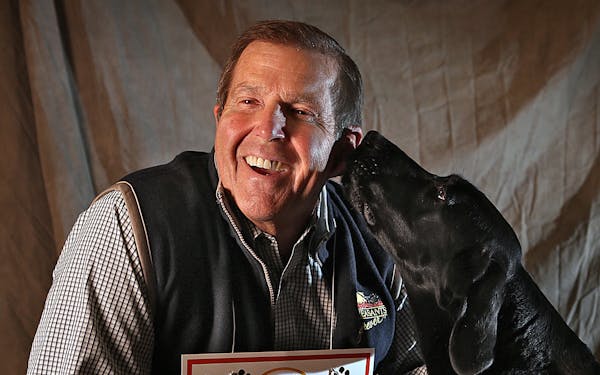BELGRADE, MINN.
Christina Traeger's cattle didn't look out of place last week grazing contentedly on a field of lush green grasses in Stearns County.
Except they were munching in a state wildlife management area — public land managed for wildlife.
It's part of a growing trend to use cattle, sheep and even goats on state, federal and private grasslands to mimic the beneficial effects on wildlife habitat that herds of wild bison once provided. "Conservation grazing" has been used for years by the U.S. Fish and Wildlife Service, state Department of Natural Resources and The Nature Conservancy — but its use has been accelerating, because of funding from the Clean Water, Land and Legacy Amendment's Outdoor Heritage Fund and the Environment and Natural Resources Trust Fund, or lottery money.
Last year, the Legislature allocated $600,000 from the Trust Fund for fencing to allow grazing on an additional 5,000 acres of public land.
Near Belgrade, the DNR used $7,000 in Legacy Amendment funds to install smooth wire fence — which Traeger has electrified — around the 160-acre Crow River Wildlife Management Area.
Prairies need occasional disturbance to remain healthy, diverse and to minimize invasive species such as brome grass and reed canary grass, and land managers have only a few options: fire, mowing, herbicides or grazing.
"We see it as another tool in the toolbox,'' said Fred Bengtson, DNR area wildlife manager in Sauk Rapids, who is making his first foray into grazing.
"We're doing it to try to improve the native prairie plants,'' he said. "We're hoping they will graze on some of the trees, brush and cool-season grasses that are encroaching on the native grasses.''
The DNR will graze 10,000 to 12,000 acres this year and intends to eventually graze 50,000 acres, a fraction of the 1.4 million acre state wildlife management area system.
Critics not convinced
Not everyone is sold on the idea.
"We've seen some of these areas, and once it gets grazed down to a nub, it's sparse and there can be craters and volcanoes that will stay for years,'' said Kevin Auslund of Eden Prairie, an outdoors activist who formed Sportsmen Take Action (sportsmentakeaction.com), a nonprofit group whose concerns include grazing.
"Each hunter should ask if these are going to become the lush grasslands the agency promises, or will they simple become pastures for grazing operations subsidized by the public,'' Auslund said.
Jim Cox of Cologne, a member of the Lessard-Sams Outdoor Heritage Council, which recommends funding of Legacy dollars, also isn't a fan.
"We don't know what effect it has on ground-nesting birds or plants,'' he said.
Bengston acknowledges that wildlife officials aren't sure what immediate impact Traeger's cattle will have on pheasants, ducks and other ground-nesting birds this spring. But he thinks the long-term benefits of improved habitat will outweigh any short-term disadvantages.
"With the cattle in this field, I'm willing to bet there will be fewer red fox, skunks and coyotes,'' Bengtson said. "If there is a loss of nesting [from the cattle] it will be offset by the lack of predators.''
Burning vs. grazing
Agencies and private land managers often burn grasslands to stimulate growth and reduce invasives, but burning has its drawbacks. The wet spring has reduced burning opportunities, and there are cost and other concerns, including smoke.
"Grazing is more reliable,'' said J.B. Bright, a U.S. Fish and Wildlife Service wildlife refuge specialist in the agency's Morris district, where about 5,000 acres were grazed last year.
"The bottom line is there's no one magic bullet; everything has a pro and con. To me, the pros of grazing outweigh the cons.''
Bengston said Traeger's cattle were feeding on brome grass, a nonnative species that greens up early and that can crowd out more desirable native grasses that green up later.
"Wildlife benefits from diversity, and our job is to create as much diversity on the landscape as we can,'' Bengston said.
He's also hoping the cattle trample and feed on cattails to help open up a wetland choked with vegetation, which would benefit waterfowl — and those who hunt them.
The cattle's hoofs will break up soil, and their waste will provide nutrients.
And Traeger noted her own pasture land is getting a needed rest from grazing, and the grass there is flourishing.
"Now there's wildlife being produced at our place that wouldn't have had that opportunity,'' said Traeger, of Avon, Minn., where she operates Rolling Hills Traeger Ranch (lovebritishwhites.com) and raises and sells grass-fed beef. She pays the DNR to graze her cattle.
"I believe in this program,'' she said.
The 121 cows will be on the parcel for 45 days. Next year, Bengston said, the area will be rested.
Last week, Traeger's cattle had only been in the field for about 10 days and already had nibbled some plants down to a few inches.
"The grass will be up to here by fall,'' said Bengtson, holding his hand to his chest. "You won't even know the cattle were in here.''
Doug Smith • doug.smith@startribune.com

MIAC title game might be Bethel vs. St. John's, but others have something to say first

Wild's muted power play comes back to bite them this time
Wild-Sharks game preview: Michael Milne called up from Iowa

Podcast: Can Gophers football make it five straight? + A kicking concern for Vikings

